그래프란?
- Vertex(node)와 Edge로 이루어진 것
- 그래프의 종류 3가지
- 무방향 그래프 (양방향 그래프)
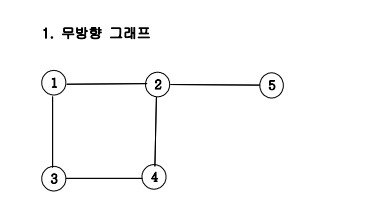
- 인접 행렬로 표현 (2차원 배열)
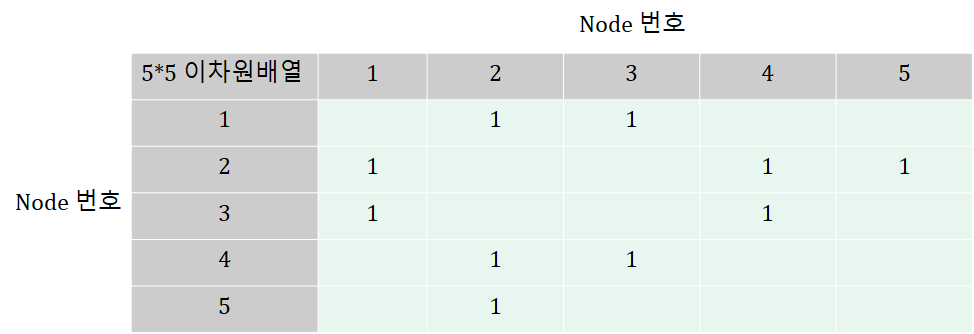
- 1은 연결된 정보
- 행에서 열로 이동한다라고 생각
- 행(node 1,2,3,4,5)이 증가하면서 연결된 열(node 1,2,3,4,5) 찾기
graph[a][b]=1;
graph[b][a]=1; 료 표현
- 방향 그래프
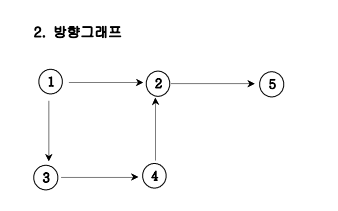
- 방향 그래프는 연결된 정보만 1로 연결
- 행에서 다음 열(Node)로 연결하는 것이다.
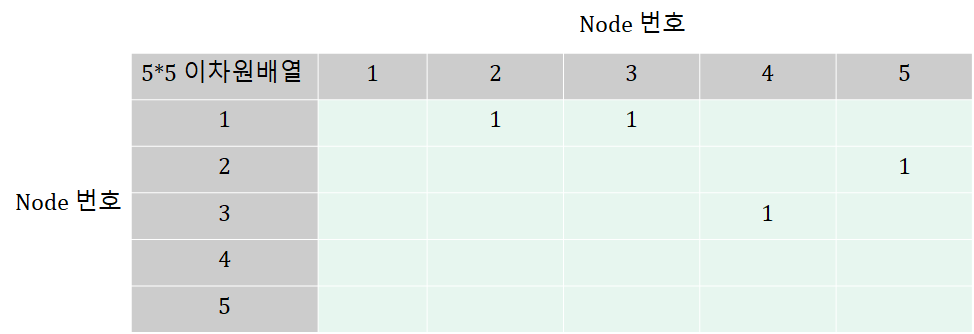
- 가중치 방향 그래프
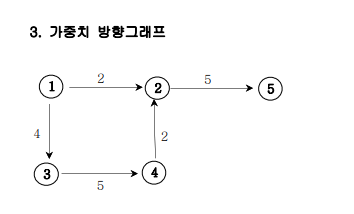
- 안에 가중치를 넣어줌
- 1번과 2번이 연결된 가중치는 2이다. ...
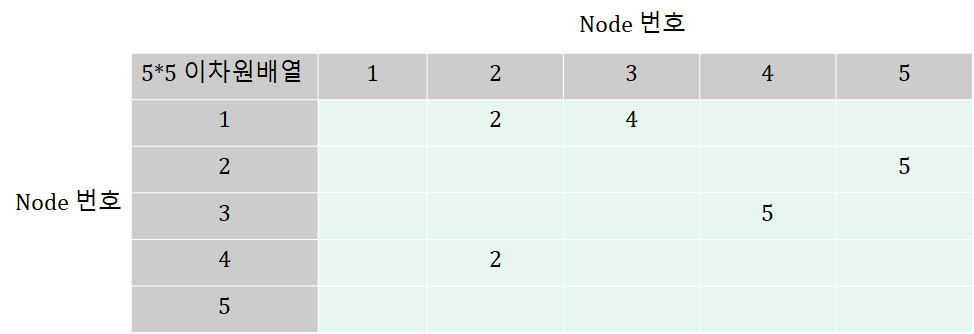
경로 탐색 (인접행렬)
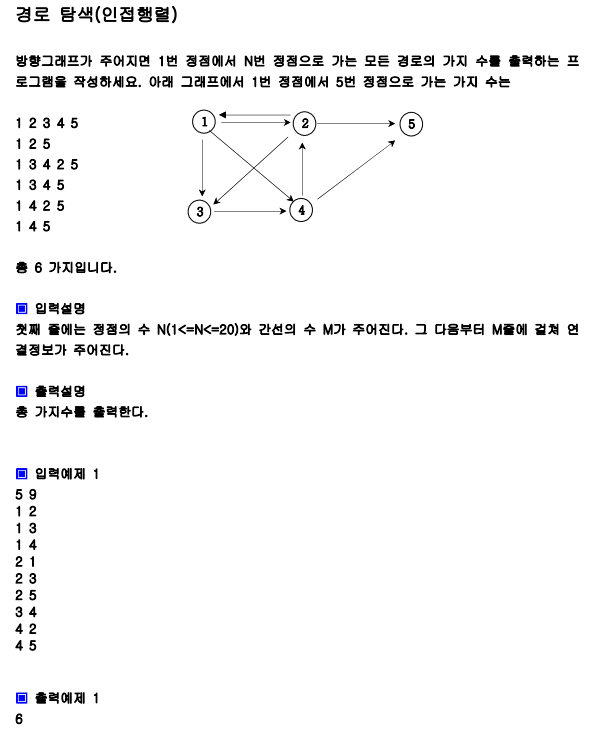
이슈
- 다음으로 가야 할 노드를 방문처리 해야되는데 들어온 노드를 방문처리하였기 때문에 문제 생김
- 따라서 순서는 다음과 같다
- if문으로 종료 조건을 명시한다
- for문을 돌면서 다음으로 방문할 노드가 연결되어 있을경우, 다음 노드를 방문처리 (현재 노드를 방문처리하는것이 아니다!)
- 그리고 dfs를 재귀로 돌린다.
- 돌린 후에는 다시 방문을 풀어준다.
package inflearn.section7_dfs;
import java.util.*;
public class 인접행렬 {
static int arr[][];
static int check[];
static int answer;
public void dfs(int node,int n) {
if (node==n) { // 종료 조건
answer++;
}
// for문은 맞는것 같은데
else {
for (int i=1;i<=n;i++) {
// 도착했으면 종료
// 종료 조건이 이상한데?!
if (arr[node][i]==1 && check[i]==0) { // 여기가 틀렸었음, 다음으로 가야 할 노드이기 때문에 check[i]=0으로 해야됨
check[i]=1; // 다음으로 가야 할 노드를 방문처리
dfs(i,n); // 다음 노드 (노드, 최종 목적지)
check[i]=0; // 다 방문 후에는 다시 체크 풀어줌
}
}
}
}
public static void main(String[] args) {
인접행렬 m1=new 인접행렬();
Scanner scan=new Scanner(System.in);
int n=scan.nextInt(); //5 (노드)
int m=scan.nextInt(); //9 (간선)
// arr[][]=new int[n+1][n+1]; // 각각을 숫자로 표현하기 위해 +1로 증가
arr=new int[n+1][n+1];
for (int i=0;i<m;i++) {
int a=scan.nextInt();
int b=scan.nextInt();
arr[a][b]=1;
}
// for (int i=1;i<arr.length;i++) {
// for (int j=1;j<arr.length;j++) {
// System.out.print(arr[i][j]);
// }
// System.out.println();
// }
// 방문 리스트는 노드를 적어준다.
check=new int[n+1];
answer=0;
// 첫번째 방문했다고 여기서 미리 해주기
check[1]=1;
m1.dfs(1,n);
System.out.println(answer);
}
}
인접리스트
- 언제 사용?
- 정점이 너무 많으면 N*N행렬로 만들어야 되기 때문에 너무 커짐
- N이 100까지는 인접행렬로 해도 된다.
- 그 이상은 인접리스트로 해결해야 됨
- 연결된것만 list로 만들어 줌
- ArrayList이용
// 갈수 있는 정보만 넣어준다.
arraylist1=[2,3,4]
arraylist2=[1,3]
arraylist3=[4]
arraylist4=[2,5]
arraylist5=[]- 이렇게 하면 graph[a][b]를 할 필요 없음 -> 가는곳은 모두 적어주었기 때문에 방문한 check배열만 보면 됨
- 핵심은 arraylist안에 arraylist 넣기
- node개수만큼 arraylist 생성하기
package inflearn.section7_dfs;
// 인접리스트는 Arraylist를 이용
import java.util.*;
public class 인접리스트 {
static int answer=0;
static int n=0;
// arraylist안에 arraylist
// 연결된 정점을 표현하기 위해
static ArrayList<ArrayList<Integer>> graph;
static int[]check;
public void dfs(int v) {
if (v==n) {
// 종료
answer++;
}
else {
// arraylist에 접근할때는 for each사용
for (int nv:graph.get(v)) {
// v번 노드와 연결된것은 nv
if (check[nv]==0) {
check[nv]=1;
dfs(nv);
check[nv]=0;
}
}
}
}
public static void main(String[] args) {
인접리스트 m1=new 인접리스트();
Scanner scan=new Scanner(System.in);
n=scan.nextInt();
int m=scan.nextInt();
graph=new ArrayList<>();
//n개의 arraylist 추가
for (int i=0;i<=n;i++) {
graph.add(new ArrayList<>());
}
for (int i=1;i<=m;i++) {
int a=scan.nextInt();
int b=scan.nextInt();
graph.get(a).add(b); // 1번 arraylist에 연결 정보를 넣는다.
}
// 첫번째 방문은 방문처리
check=new int [n+1];
check[1]=1;
m1.dfs(1);
System.out.println(answer);
}
}
인접리스트 + BFS로 최단 거리 찾기
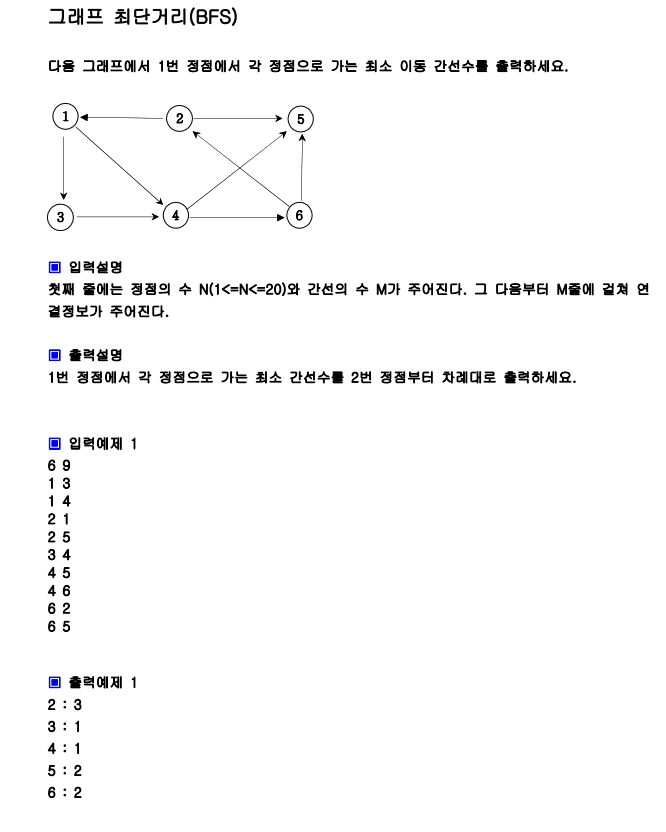
해결방법
-
DIS를 이용
- DIS는 최단거리를 기록하는 배열
- 각 노드까지 가는 최단거리를 기록- dis[n]=dis[n-1]+1 //dis[n-1]에는 해당 노드까지 가는 최단거리가 기록

- dis[n]=dis[n-1]+1 //dis[n-1]에는 해당 노드까지 가는 최단거리가 기록
-
이슈
- 최단거리는 갔던 Node를 다시 풀어주지 않는다. (check배열)
- 인접리스트는 arraylist를 사용하며 for Each를 사용해서 풀자
코드
package inflearn.section7_bfs;
// 인접리스트로 그래프 최단 거리 구하기
// 최단거리를 기록하는 곳은 dis배열을 이용한다
import java.util.*;
public class 인접리스트 {
static ArrayList<ArrayList<Integer>>graph;
static int check[];
static int dis[];
static int n;
public void bfs(int node) {
Queue<Integer>queue=new LinkedList<>();
queue.add(node);
while (!queue.isEmpty()) {
int curr=queue.poll();
int size=queue.size();
for (int nx:graph.get(curr)) {
if (check[nx]==0) {
check[nx]=1;
queue.add(nx);
dis[nx]=dis[curr]+1; // 현재 연결된 거에 +1해주기
// check[nx]=0; // 최단거리는 갔던 곳을 또 안가기 때문에 이건 해주지 않는다.
}
}
}
}
public static void main(String[] args) {
Scanner scan=new Scanner(System.in);
n=scan.nextInt();
int m=scan.nextInt();
graph=new ArrayList<>();
for (int i=0;i<=n;i++) {
graph.add(new ArrayList<Integer>());
}
for (int i=0;i<m;i++) {
int a=scan.nextInt();
int b=scan.nextInt();
graph.get(a).add(b);
}
check=new int[n+1];
dis=new int[n+1];
인접리스트 bf=new 인접리스트();
check[1]=1;
dis[1]=0;
bf.bfs(1);
// 2부터 ~N까지 출력해보기
for (int i=2;i<=n;i++) {
System.out.println(i + ":" + dis[i]);
}
}
}

쉽게 이해할 수 있게 잘 정리 되어 도움 받고 갑니다. 감사합니다 :)